| |
| |
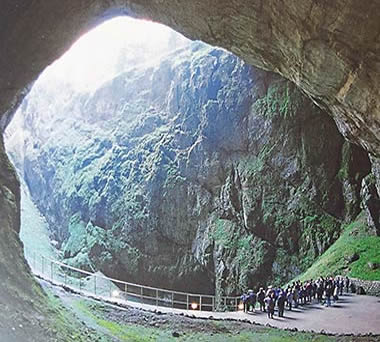
|
|
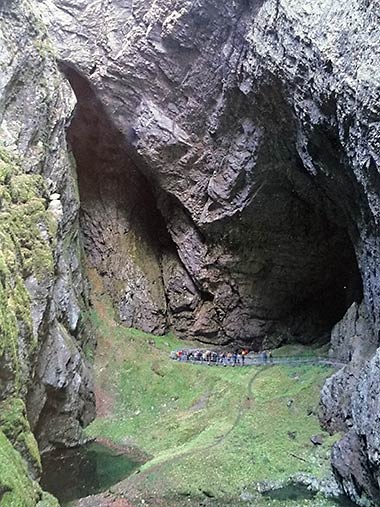 |
|
| |
The "great reveal" of the Macocha Abyss from behind. Photo, Petr Zajíček |
|
The Macocha Abyss from the opposite side. Photo, Petr Zajíček |
|
I must take off my objective reporter hat and share a personal response to this experience. Upon arriving at the "great reveal" of the Macocha Abyss, unexpectedly and suddenly, an overwhelming surge of emotion—neither sad nor joyous, but extremely powerful—engulfed, overtook my being. Quite surprisingly, I found myself sobbing, and gave in to what appeared to be the beauty, the grandeur, the majesty and profundity of nature and of this collective moment. At that time, little did I know that there exists a well-known psychological syndrome called the Stendhal Effect, experienced as a response to the magnificent beauty of a performance, a piece of art, a sonata, a symphony, the sheer and utter wonderousness of the uncontrollable creativity of nature. And, at that time, also little did I know about the legend of this Abyss.
| |
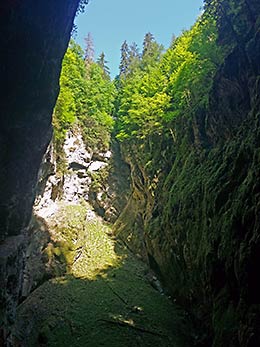 |
|
 |
|
| |
The chasm of the Macocha Abyss from ground level. |
|
The chasm of the Macocha Abyss from the suicide bridge above. |
|
A short version of the historical legend of the Macocha Abyss is briefly told by the tour guide: Once upon a time, there lived a widower with his small son. By remarrying, he provided his son with a new mother and later a new baby boy was born. The first son was a healthy boy, but the second was constantly ill. The step-mother hated her step-son and took advice from an old woman herbalist who told her if the stepson died, her real son would get well. She took the stepson to pick berries by the steep abyss and pushed him in. However, he fell only to a nearby ledge and was rescued by some woodsmen who heard his cries. The stepmother had meanwhile rushed home in anticipation of finding a cured son only to find him stone cold dead. In despair, she took the dead baby, rushed back to the abyss and threw herself into the chasm below. Thus the abyss came to be known as Macocha, or “step-mother.”
Here is a more personal, riveting and current recounting of the legend as it relates to present times.
Hana Suchánková, our guide to the Moravian Karst region, has been working in the Czech Republic tourist industry for quite a few decades. Her knowledge runs deep and her sense of history and culture is wide. She shared the following stories about the Macocha Abyss and the “suicide” bridge above it. What follows is her own recounting of the sad and somewhat gory details about the Macocha legend.
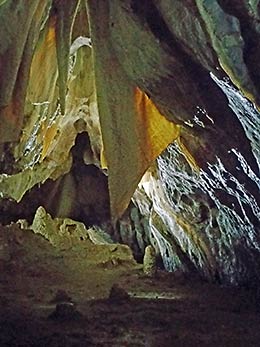
Striking formations along the underground river.
“Macocha is the deepest abyss in Central Europe – 138 m (453ft) below ground level. There are many legends but also sad and true stories. There are two bridges — the top one (453ft above the abyss) is where the suiciders jump from. They usually land on a stone at the bottom of the abyss — that is why it is called the “suiciders stone.” Even professor Karel Absolon, one of the investigators of the whole karst system, writes about that in his book. It is the target of suiciders from a wide region, often people who had not been there before. The “dry” way how to get to the bottom of the abyss was only discovered at the beginning of the twentieth century. Until then there had been an unpopular and unpaid job of recovering the bodies — the rescuer had to abseil down using the ropes. Prof. Absolon knew about two – Martin Kala and Josef Nejezchleb. They had various ways of getting the bodies up. Once one of them tied himself to the dead body, “embraced” it and was pulled up together with the dead person. They were tied face to face. When they were a few meters above the bottom, a piece of rock underneath them collapsed. When they were near the top, the bodies started swaying and they nearly hit the rock face. But in the end he managed. A Styrian alpinist, Pucher, wanted to be the first one to climb down without using ropes. He collapsed, tried to catch on the little trees and bushes but without success and got killed. No one has ever managed to climb down like this.”

Formations along the underground river.
“So far all those who tried to kill themselves this way succeeded. The cave staff go through the tourist path every morning before they let tourists in, to check the lights, the rocks and also the possible dead bodies and so are the first to find the bodies. Once they got a text from a man who discovered a bike, leaning against the railing the whole day, which looked suspicious. On the camera system, they found a man climbing over the railing. The police and fire brigade were looking for the body the whole day. Then they called the divers and those recovered the body from the lake. There is a net above the lake to catch the bodies, but sometimes it is not enough. The lake looks like a puddle but is 50meters deep. The firefighters are called to help in difficult conditions. In 2016, a well-known doctor from a Brno hospital ended his life in the lake. His motives are unknown — he did not leave a farewell letter. One of the hypothesis was the burnt-out syndrome — he was spending whole days at work. Most suiciders jump during the night but there have been cases when their jump was witnessed by tourists. In 2013 there was a young man who was first saved — an employee noticed him standing behind the railing. He called the police. They managed to talk him out of that. But a week later there was no one around and he jumped.”
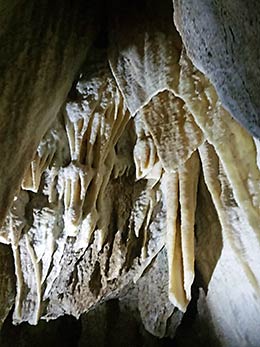
Stalagtite formations along the underground river.
The Punkva Caves and Macocha Abyss - a powerfully emotional and stunning center in the bowels of the Czech earth. The legends read like Grimm Fairy Tales, and like many fairy tales, are grim to be sure. It is fascinating to try to understand how historical legends such as these influence cultures.
For further information: www.caves.cz, www.moravskykras.net, www.topdestinations.cz
Lynn Rosen, co-author of “Camping Washington,” Falcon Press, Emmy award-winner, ski guidebook editor and writer, and theater critic, has a long history of both broadcast and print journalism.
|
|